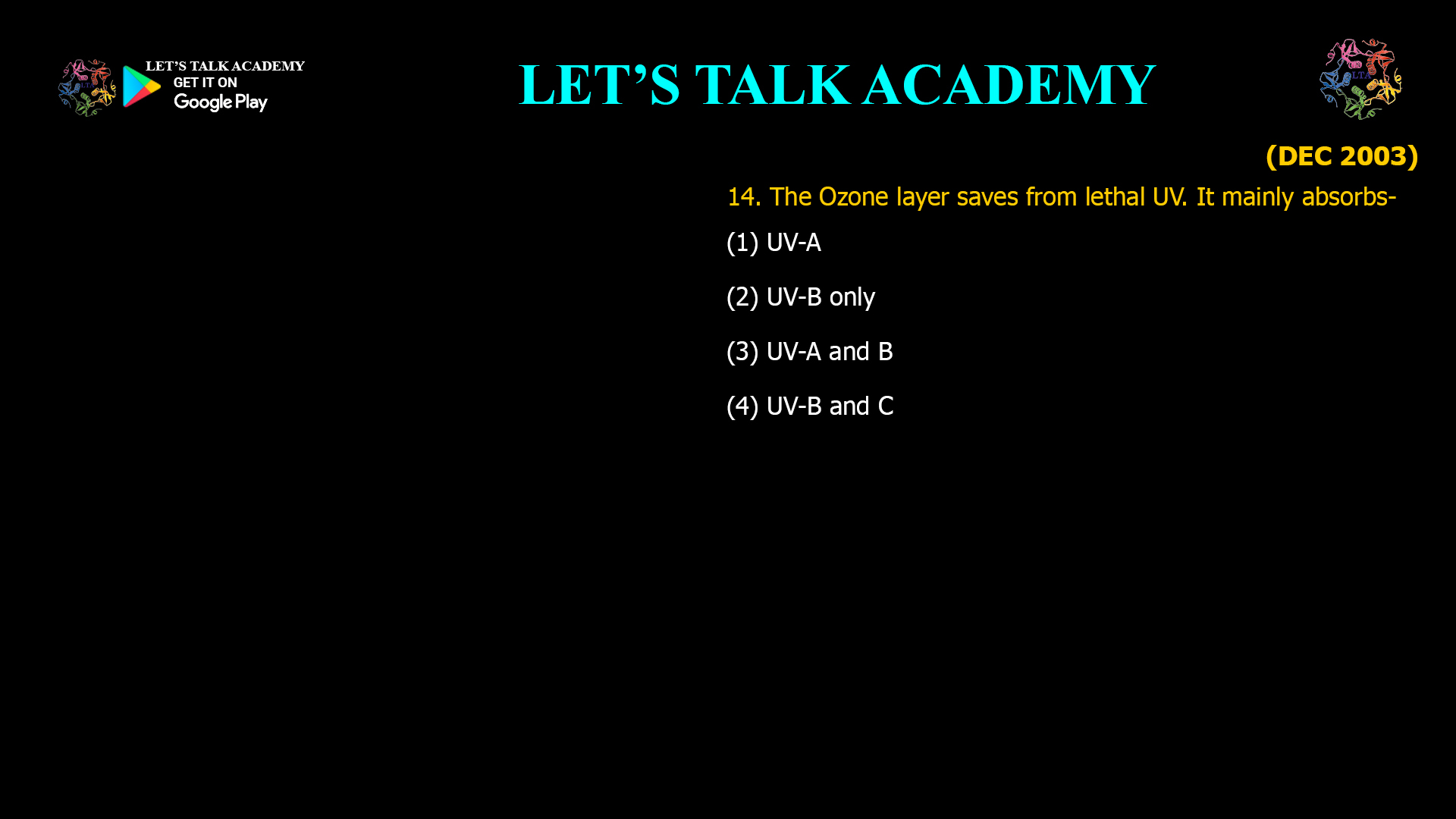- The Ozone layer saves from lethal UV. It mainly absorbs-
(1) UV-A (2) UV-B only
(3) UV-A and B (4) UV-B and C
The ozone layer is a crucial component of Earth’s atmosphere, providing a natural barrier against the sun’s most harmful ultraviolet (UV) radiation. Understanding which types of UV rays the ozone layer absorbs is essential for appreciating its role in protecting life on Earth. This article explores the different categories of UV radiation, how the ozone layer filters them, and why its absorption of UV-B and UV-C is so important for human health and the environment.
The Spectrum of Ultraviolet Radiation
Ultraviolet radiation from the sun is divided into three main categories based on wavelength:
-
UV-A (315–400 nm): The longest wavelength UV, which penetrates deep into the skin and is responsible for tanning and skin aging. Most UV-A reaches the Earth’s surface.
-
UV-B (280–315 nm): Medium wavelength UV, strongly absorbed by the ozone layer. UV-B is the primary cause of sunburn, skin cancer, and cataracts in humans.
-
UV-C (100–280 nm): The shortest and most energetic UV, extremely harmful to all living organisms. UV-C is completely absorbed by the ozone layer and does not reach the Earth’s surface.
How the Ozone Layer Filters UV Radiation
The ozone layer is concentrated in the stratosphere, about 15–35 kilometers above the Earth’s surface. Ozone molecules (O₃) are highly effective at absorbing certain wavelengths of UV radiation:
-
UV-C Absorption: The ozone layer absorbs nearly all UV-C radiation, preventing it from reaching the Earth’s surface. Without this protection, UV-C would sterilize the surface and make life as we know it impossible.
-
UV-B Absorption: Ozone absorbs most UV-B radiation, significantly reducing its intensity at the surface. However, some UV-B, especially at its longer wavelengths, does reach the ground and is responsible for sunburn and skin cancer when exposure is excessive.
-
UV-A Absorption: Ozone absorbs little to no UV-A, so most of this radiation passes through the atmosphere and reaches the surface. While less harmful than UV-B and UV-C, UV-A can still cause skin aging and indirect DNA damage.
The Importance of Ozone’s Absorption
The absorption of UV-B and UV-C by the ozone layer is critical for several reasons:
-
Protection from DNA Damage: UV-B and UV-C are both capable of damaging DNA, leading to mutations, cancer, and other health problems in humans and animals.
-
Prevention of Ecosystem Harm: Excessive UV-B exposure harms phytoplankton, the base of the marine food chain, and can reduce crop yields by damaging plant tissues.
-
Reduction of Health Risks: By filtering out most UV-B and all UV-C, the ozone layer helps prevent skin cancers, cataracts, and immune system suppression in humans.
The Absorption Process
When ozone molecules in the stratosphere absorb UV photons, they break apart into an oxygen molecule (O₂) and a free oxygen atom (O). These components can later recombine to form ozone again, maintaining the ozone layer’s protective function. This continuous cycle of formation and destruction allows the ozone layer to act as a dynamic shield against harmful UV radiation.
What Happens When the Ozone Layer Is Depleted?
Ozone depletion, caused by human-made chemicals such as chlorofluorocarbons (CFCs), leads to an increase in the amount of UV-B reaching the Earth’s surface. This results in higher rates of skin cancer, cataracts, and other UV-related health problems, as well as harm to ecosystems and agriculture. The “ozone hole” over Antarctica is a dramatic example of the consequences of ozone depletion.
Comparing the Options
Let’s review the options in the context of ozone’s absorption spectrum:
-
UV-A: Not absorbed by the ozone layer. Most UV-A reaches the surface.
-
UV-B only: The ozone layer absorbs most UV-B, but not exclusively; it also absorbs UV-C.
-
UV-A and B: Incorrect, because the ozone layer does not absorb UV-A.
-
UV-B and C: Correct. The ozone layer absorbs both UV-B and UV-C, providing maximum protection against the most harmful UV radiation.
The Ozone Layer’s Role in Climate and Life
Beyond its role in UV absorption, the ozone layer also influences climate by absorbing solar energy and warming the stratosphere. This temperature structure helps maintain the stability of Earth’s atmosphere and weather patterns.
Key Takeaways
-
The ozone layer absorbs UV-B and UV-C radiation, protecting life from their harmful effects.
-
Most UV-A reaches the Earth’s surface, as ozone does not absorb it.
-
UV-B is responsible for sunburn, skin cancer, and cataracts; UV-C is even more harmful but is completely blocked by the ozone layer.
-
Ozone depletion increases UV-B exposure, raising the risk of health and environmental problems.
Summary Table
| UV Type | Wavelength Range | Absorbed by Ozone? | Reaches Earth’s Surface? |
|---|---|---|---|
| UV-A | 315–400 nm | No | Yes |
| UV-B | 280–315 nm | Mostly | Some |
| UV-C | 100–280 nm | Completely | No |
Conclusion
The ozone layer is Earth’s primary defense against the sun’s most damaging ultraviolet radiation. It mainly absorbs UV-B and UV-C, preventing these harmful rays from reaching the surface and protecting all forms of life from genetic damage, cancer, and ecosystem disruption. While some UV-B does reach the ground—especially when the ozone layer is depleted—the absorption of both UV-B and UV-C is what makes the ozone layer so vital for life on our planet.
In summary, the correct answer is:
(4) UV-B and C.
The ozone layer saves us from lethal UV by mainly absorbing UV-B and UV-C radiation. Understanding and protecting this natural shield is essential for the health of people, animals, and ecosystems worldwide.




3 Comments
Kirti Agarwal
November 6, 2025UV b and c
Kajal
November 15, 2025Option 4
Sakshi Kanwar
November 28, 2025UV-B and C